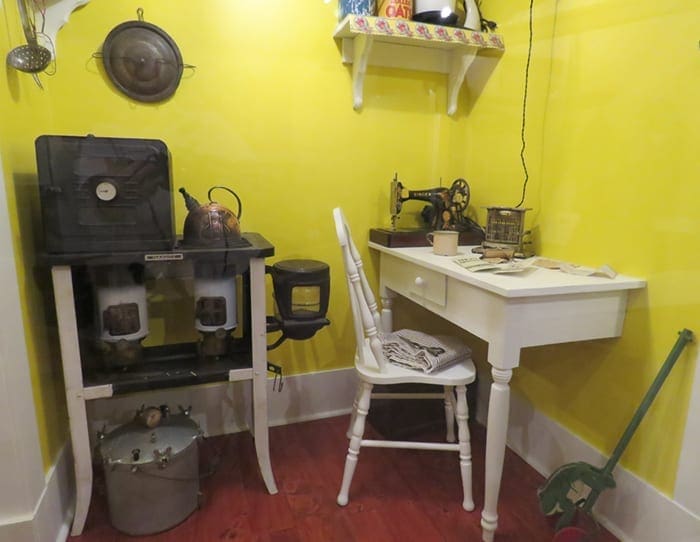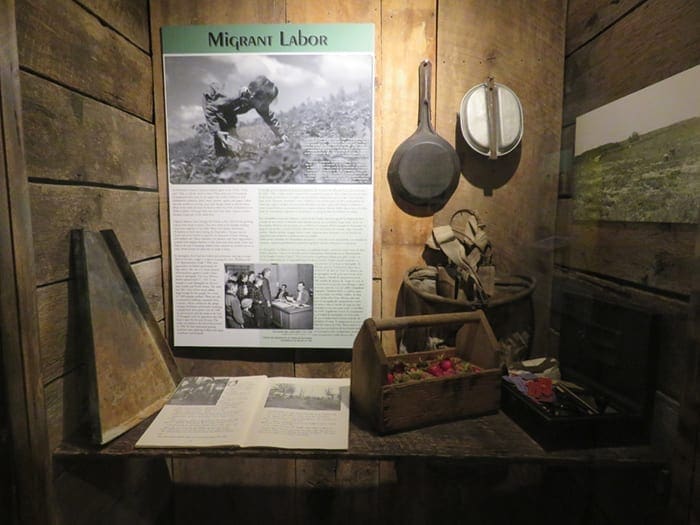1920 to 1950
Core ExhibitAgriculture was the economic engine for Northwest Arkansas in the 1920s through the 1950s. Apples, peaches, and strawberries were leading products going into the 1920s. When the Welch Grape Juice Company built a plant in Springdale in 1922, grape production boomed. Tomatoes and green beans became cash crops also. At the same time, the poultry industry was beginning to take shape and was rapidly growing. The era also saw the introduction of diversified farming, a method that involves growing a variety of crops and livestock. It was promoted by the University of Arkansas Department of Agriculture and the Cooperative Extension Service to help Ozark farms secure a steadier source of income.
During the 1930s a national economic crisis affected the livelihood of Americans all across the United States. What came to be known as the Great Depression began after the worst stock market crash in history on October 24, 1929. In Arkansas more than 200 banks failed and half of its factories closed. There was also a record drought in 1930 which

devastated farmers. People lost their money, jobs, and farms. When Franklin D. Roosevelt became president in 1933 he promised to take action. He offered the American people a “New Deal,” a series of federal programs that put people back to work and provided relief to the most needy.
The New Deal

“Local Industries,” a WPA mural created for the Springdale post office by artist Natalie Henry.
The New Deal consisted of several agencies, such as the Work Projects Administration and the Civilian Conservation Corps, which gave grants and loans usually for workers’ pay, while state and local governments supplied the land, materials, and equipment. In Northwest Arkansas workers built roads, schools, bridges, and parks like Devil’s Den State Park and Lake Wedington. Others worked as clerks at the University of Arkansas or county courthouses, canning kitchen supervisors, and seamstresses. Artists employed through the Federal Art Project painted murals and made sculptures for post offices in Springdale, Siloam Springs, and Berryville. The Writers’ Project collected oral histories from early settlers and enslaved African Americans and wrote profiles of Arkansas towns for a guidebook that was part of the national American Guide Series.
World War II

Chris Manuel family tend their victory garden, Fayetteville, 1943. Washington County Historical Society Collection (P-2437)
The Depression came to an end with World War II. With the Japanese attack on Pearl Harbor December 7, 1941, the United States was suddenly drawn into the conflict raging in Europe. Before the war ended four years later, the life of every individual had been affected in some way. It was an all-out effort to win the war to make the world “safe for democracy.”
The war effort caused a massive movement of people to places they were needed. Meat, sugar, tires, and gasoline were rationed. Speed limits were lowered to conserve fuel. Factories switched from making cars, radios, and refrigerators to tanks, guns, and airplanes. Workers paid higher taxes and bought war bonds to help fund the war effort. Children collected scrap metal, rubber, and grease. Women who stayed home took on new roles in agriculture, industry, and business. The effort to arm America and her allies fueled a huge industrial boom, and every man and woman who wanted a job had one. The Great Depression was over!
In Northwest Arkansas there were some food-processing plants, and pilots were trained at the University, but there were no major industries or military bases. Most Ozarkers had to leave home to be part of the war effort. Many were leaving the hills for the first time, and some would never return. Those who did return were changed people, bringing home new ideas and ambitions.
After the War
 After World War II ended many people who had gone off to military service or to factory work in cities returned to Northwest Arkansas to take up their lives again. Soldiers who had seen their education interrupted returned to their studies at the University of Arkansas with tuition provided by the Servicemen’s Readjustment Act of 1944, commonly called the G. I. Bill.
After World War II ended many people who had gone off to military service or to factory work in cities returned to Northwest Arkansas to take up their lives again. Soldiers who had seen their education interrupted returned to their studies at the University of Arkansas with tuition provided by the Servicemen’s Readjustment Act of 1944, commonly called the G. I. Bill.
But there was also a large number of former residents who did not return. Many found better opportunities for work. It was an era of significant population loss in Arkansas that led to the decline of many small towns and farm communities. The state’s 1948 school consolidation law, which closed schools with fewer than 350 pupils, also had an impact.
Agriculture continued to be the economic engine of Northwest Arkansas but farming was changing. There were fewer but larger farms. The loss of available labor helped to usher in the use of mechanized farm equipment, like picking machines. Electricity, brought to farms through the Rural Electrification program, also modernized farms. A commercial cattle industry started. Old crop fields were converted to pasture or hay and thoroughbred stock was brought in to replace scrub stock.
The poultry industry continued to grow. Tyson’s started “vertical integration” in 1943, a system that controls every part of production, from hatchery to retail sales of broilers. By 1950 it was the leading firm in the area. By 1955 poultry was second only to cotton as the largest source of agricultural income in Arkansas.

Agriculture was the economic engine for Northwest Arkansas in the 1920s through the 1950s. Apples, peaches, and strawberries were leading products going into the 1920s. When the Welch Grape Juice Company built a plant in Springdale in 1922, grape production boomed. Tomatoes and green beans became cash crops also. At the same time, the poultry industry was beginning to take shape and was rapidly growing. The era also saw the introduction of diversified farming, a method that involves growing a variety of crops and livestock. It was promoted by the University of Arkansas Department of Agriculture and the Cooperative Extension Service to help Ozark farms secure a steadier source of income.
During the 1930s a national economic crisis affected the livelihood of Americans all across the United States. What came to be known as the Great Depression began after the worst stock market crash in history on October 24, 1929. In Arkansas more than 200 banks failed and half of its factories closed. There was also a record drought in 1930 which devastated farmers. People lost their money, jobs, and farms. When Franklin D. Roosevelt became president in 1933 he promised to take action. He offered the American people a “New Deal,” a series of federal programs that put people back to work and provided relief to the most needy.
The New Deal

“Local Industries,” a WPA mural created for the Springdale post office by artist Natalie Henry.
The New Deal consisted of several agencies, such as the Work Projects Administration and the Civilian Conservation Corps, which gave grants and loans usually for workers’ pay, while state and local governments supplied the land, materials, and equipment. In Northwest Arkansas workers built roads, schools, bridges, and parks like Devil’s Den State Park and Lake Wedington. Others worked as clerks at the University of Arkansas or county courthouses, canning kitchen supervisors, and seamstresses. Artists employed through the Federal Art Project painted murals and made sculptures for post offices in Springdale, Siloam Springs, and Berryville. The Writers’ Project collected oral histories from early settlers and enslaved African Americans and wrote profiles of Arkansas towns for a guidebook that was part of the national American Guide Series.
World War II

Chris Manuel family tend their victory garden, Fayetteville, 1943. Washington County Historical Society Collection (P-2437)
The Depression came to an end with World War II. With the Japanese attack on Pearl Harbor December 7, 1941, the United States was suddenly drawn into the conflict raging in Europe. Before the war ended four years later, the life of every individual had been affected in some way. It was an all-out effort to win the war to make the world “safe for democracy.”
The war effort caused a massive movement of people to places they were needed. Meat, sugar, tires, and gasoline were rationed. Speed limits were lowered to conserve fuel. Factories switched from making cars, radios, and refrigerators to tanks, guns, and airplanes. Workers paid higher taxes and bought war bonds to help fund the war effort. Children collected scrap metal, rubber, and grease. Women who stayed home took on new roles in agriculture, industry, and business. The effort to arm America and her allies fueled a huge industrial boom, and every man and woman who wanted a job had one. The Great Depression was over!
In Northwest Arkansas there were some food-processing plants, and pilots were trained at the University, but there were no major industries or military bases. Most Ozarkers had to leave home to be part of the war effort. Many were leaving the hills for the first time, and some would never return. Those who did return were changed people, bringing home new ideas and ambitions.
After the War
 After World War II ended many people who had gone off to military service or to factory work in cities returned to Northwest Arkansas to take up their lives again. Soldiers who had seen their education interrupted returned to their studies at the University of Arkansas with tuition provided by the Servicemen’s Readjustment Act of 1944, commonly called the G. I. Bill.
After World War II ended many people who had gone off to military service or to factory work in cities returned to Northwest Arkansas to take up their lives again. Soldiers who had seen their education interrupted returned to their studies at the University of Arkansas with tuition provided by the Servicemen’s Readjustment Act of 1944, commonly called the G. I. Bill.
But there was also a large number of former residents who did not return. Many found better opportunities for work. It was an era of significant population loss in Arkansas that led to the decline of many small towns and farm communities. The state’s 1948 school consolidation law, which closed schools with fewer than 350 pupils, also had an impact.
Agriculture continued to be the economic engine of Northwest Arkansas but farming was changing. There were fewer but larger farms. The loss of available labor helped to usher in the use of mechanized farm equipment, like picking machines. Electricity, brought to farms through the Rural Electrification program, also modernized farms. A commercial cattle industry started. Old crop fields were converted to pasture or hay and thoroughbred stock was brought in to replace scrub stock.
The poultry industry continued to grow. Tyson’s started “vertical integration” in 1943, a system that controls every part of production, from hatchery to retail sales of broilers. By 1950 it was the leading firm in the area. By 1955 poultry was second only to cotton as the largest source of agricultural income in Arkansas.
